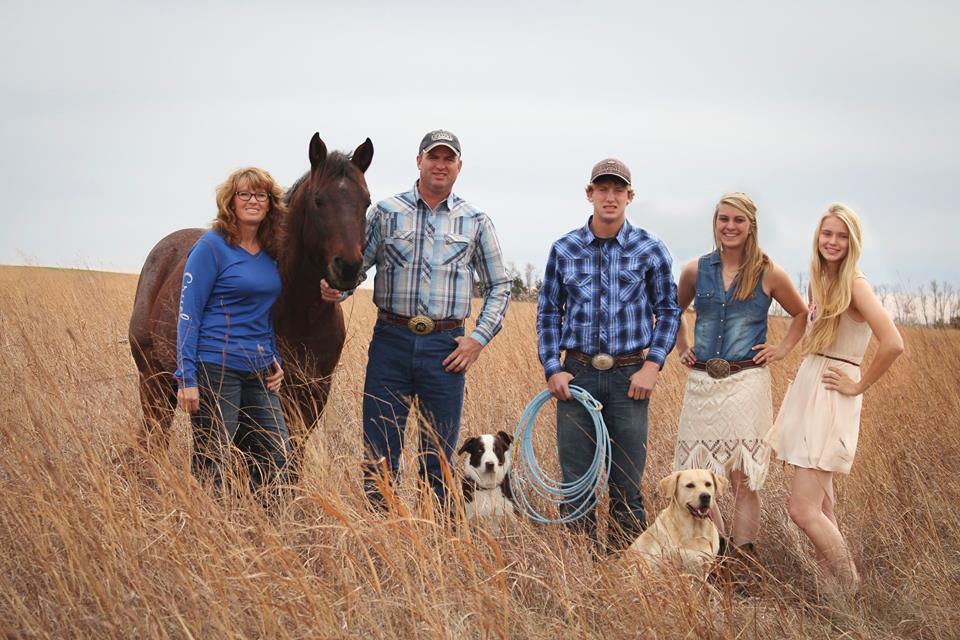Meet the Kahnke family. They have some kind words to share and will be kicking off the next series of blog posts. If you haven’t read the Why Precast series, check them out! Stay tuned for our next series: On the Farm.
It’s incredible how a simple, cost-effective, but a well-built machine like the patented Easy Rake silage facer and a Hanson Silo bunker system can do so much in so little of time, and still save you stacks of money in production costs to raise your profits.
Chad Kahnke of CCK Angus ranch in Florence, SD, is a believer in both these Hanson Silo products and also with the Secure Covers™ Hanson provides to make his 450 head registered and purebred cow/calf operation run like a well-oiled machine. His is a family operation that he began in 1989, with his wife, Hollie. They have a son, Charlie, and two daughters, Emily and Evie. In addition to the 900 head of cattle, they have 1,000 acres of tillable ground where they raise corn and soybeans; the rest is pastureland. When his Angus are market-ready, they get shipped to Ft. Pierre Livestock in Ft. Pierre, SD.
After Kahnke crunched the numbers, he saw that it would streamline his operation and save him money in the long run. A Hanson Silo bunker system, Easy Rake and Secure Covers,™ he says are also real time savers. And as they say, “Time is Money!”
“We were using round bales of straw, and we put plastic on the inside of the bales and put silage inside that before we got the bunkers. We don’t use bales or plastic anymore, we just put it inside the cement and cover with plastic on the top and then the green Secure Covers on the top of it. This was the first time we ever used it. At first, we did 160 ft. with that and 80 ft. without it, using tires. It’s so much easier to use than with tires. Covering the pile is way faster, and manual labor is way less. It’s crazy how good it works, said Kahnke. “I was worried when I saw it kind of moving with the wind, hoping the corn silage wouldn’t be moldy. But when we opened that bunker up, it was just perfect right to the top.”
He first saw Hanson bunkers at a neighbors ranch and immediately thought they were the real deal. He said he placed his order with Hanson Silo in July, and by September, Hanson had it all set up. Hanson trucked out three bunker panels to a semi. The bunker system is set up in an “H” formation.
The layout is set up with a divider wall in-between. It’s 16 ft. tall x 50 ft. wide x 240 ft. long using “L” and “T-shaped” bunker walls. He did it that way so it could be emptied each year. They start on one side one year and then the other side the following year so that the silage won’t sit there for more than one year. The divider makes the bunker more versatile. If one side is empty he can also use it for oats or haylage or whatever and use the other side for corn silage.
“We went higher and longer, so in about the same area as we did before, we would chop around 100 acres of corn, and last year when it was completely empty, and we had 25-26-ton corn it took 180 acres of corn to make that bunker completely full. It’s taller than we were doing because we only went three bales high. It takes up less space than we did before when we went three bales wide. It also gives us more room in the feeding area.” explained Kahnke.
Mike Hanson, director of business development at Hanson Silo, said the bunker system has more than one advantage.
“This also resulted in unpacked feed and a feast for rats and no spoilage. In 2015 Kahnke bought a precast concrete bunker system from us and has never looked back,” said Hanson.
His nutritionist from Agri-King told Kahnke he has some of the best silage around. “It’s incredible; we had really good silage before. Our nutritionist was just out again today and told us it’s absolutely perfect silage.”
“There’s going to be less waste; we used to have to buy the straw to put the walls up. It will be way less baling, fuel and trucking; it’s going to be a huge difference. And just the manual labor — it took us about two weeks to bale it, haul it home and put the walls up, now we just fill it up. You have a certain amount of spoilage on the bales too. The first row of bales would get wet from rain and melting snow resulting in a certain amount of spoilage. Just on the bales that we used to buy every year, with what I paid down on it will pay the bunker payment every year. I think the bunker will pay for itself in no time” expressed Kahnke.
Thanks Kahnke family, enjoy your hard work!

